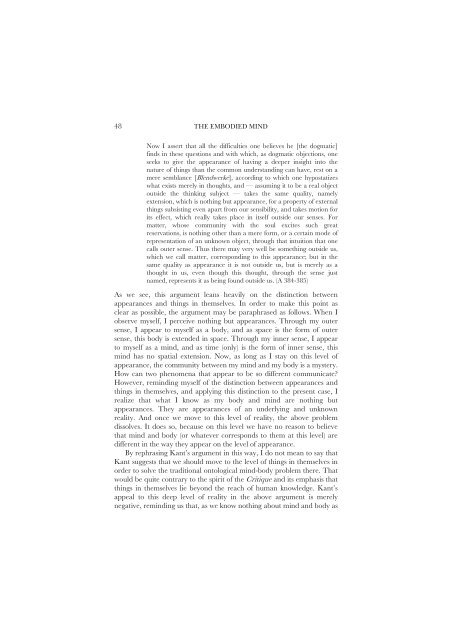BODY AND PRACTICE IN KANT
BODY AND PRACTICE IN KANT
BODY AND PRACTICE IN KANT
You also want an ePaper? Increase the reach of your titles
YUMPU automatically turns print PDFs into web optimized ePapers that Google loves.
48<br />
THE EMBODIED M<strong>IN</strong>D<br />
Now I assert that all the difficulties one believes he [the dogmatic]<br />
finds in these questions and with which, as dogmatic objections, one<br />
seeks to give the appearance of having a deeper insight into the<br />
nature of things than the common understanding can have, rest on a<br />
mere semblance [Blendwerke], according to which one hypostatizes<br />
what exists merely in thoughts, and — assuming it to be a real object<br />
outside the thinking subject — takes the same quality, namely<br />
extension, which is nothing but appearance, for a property of external<br />
things subsisting even apart from our sensibility, and takes motion for<br />
its effect, which really takes place in itself outside our senses. For<br />
matter, whose community with the soul excites such great<br />
reservations, is nothing other than a mere form, or a certain mode of<br />
representation of an unknown object, through that intuition that one<br />
calls outer sense. Thus there may very well be something outside us,<br />
which we call matter, corresponding to this appearance; but in the<br />
same quality as appearance it is not outside us, but is merely as a<br />
thought in us, even though this thought, through the sense just<br />
named, represents it as being found outside us. (A 384-385)<br />
As we see, this argument leans heavily on the distinction between<br />
appearances and things in themselves. In order to make this point as<br />
clear as possible, the argument may be paraphrased as follows. When I<br />
observe myself, I perceive nothing but appearances. Through my outer<br />
sense, I appear to myself as a body, and as space is the form of outer<br />
sense, this body is extended in space. Through my inner sense, I appear<br />
to myself as a mind, and as time (only) is the form of inner sense, this<br />
mind has no spatial extension. Now, as long as I stay on this level of<br />
appearance, the community between my mind and my body is a mystery.<br />
How can two phenomena that appear to be so different communicate?<br />
However, reminding myself of the distinction between appearances and<br />
things in themselves, and applying this distinction to the present case, I<br />
realize that what I know as my body and mind are nothing but<br />
appearances. They are appearances of an underlying and unknown<br />
reality. And once we move to this level of reality, the above problem<br />
dissolves. It does so, because on this level we have no reason to believe<br />
that mind and body (or whatever corresponds to them at this level) are<br />
different in the way they appear on the level of appearance.<br />
By rephrasing Kant’s argument in this way, I do not mean to say that<br />
Kant suggests that we should move to the level of things in themselves in<br />
order to solve the traditional ontological mind-body problem there. That<br />
would be quite contrary to the spirit of the Critique and its emphasis that<br />
things in themselves lie beyond the reach of human knowledge. Kant’s<br />
appeal to this deep level of reality in the above argument is merely<br />
negative, reminding us that, as we know nothing about mind and body as
















